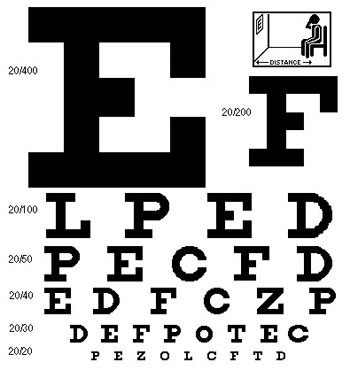
A Snellen eye chart is used to test visual acuity.
What is Vision Loss?
The legal definition of blindness is 20/200 vision or worse. Vision loss is measured in several ways:
Visual Acuity
Visual acuity is typically measured by reading a Snellen chart from 20 feet away. Near vision is tested by reading from a card held 14 inches away from your face. The results indicate how clearly a person is able to distinguish details and the shapes of objects.
Visual acuity is expressed as a fraction.
- The top number refers to how far the person is standing from the chart, usually 20 feet.
- The bottom number indicates the distance at which a person with normal eyesight can read the same line. The higher the bottom number, the more limited the person’s vision.
For example, a line read correctly at 20 feet by someone with 20/40 vision could be read by a person with normal vision from 40 feet.
From a driving perspective:
- 20/20 vision is considered normal vision.
- 20/40 vision in at least one eye is required to pass a driving test.
- 20/200 vision or worse is the legal definition of blindness.
Visual Field Test
The visual field refers to the total area in which objects can be seen using side (peripheral) vision while the person focuses on a central point. A normal visual field for both eyes is 180 degrees. Loss of vision field, or tunnel vision, can be caused by retinitis pigmentosa, glaucoma, stroke and other disorders. A visual field of 20 degrees or less is considered legally blind.
Light Perception
Light perception is the ability to tell the difference between light and dark, or daylight and nighttime. An individual can have severely reduced vision and still be able to distinguish between light and dark. A person who cannot perceive light is totally blind.
